Caring for your kitten
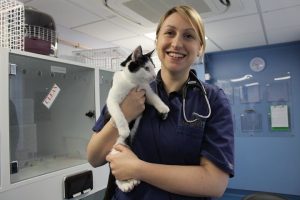
By Samantha Taylor BVetMed(Hons) CertSAM DipECVIM-CA FRCVS
EBVS® European Veterinary Specialist in Small Animal Internal Medicine
RCVS Recognised Specialist in Feline Medicine
Associate of the American College of Veterinary Internal Medicine
Veterinary Specialist Lead at The International Society of Feline Medicine (ISFM)
Honorary Lecturer in Small Animal Medicine at the University of Surrey
Introduction
Caring for a kitten is great fun! They are bundles of energy and love to play. However, it is also a large responsibility as actions now can have a significant impact upon the kitten’s whole life ahead. Appropriate feeding, introductions and healthcare now can mean many years of mental and physical wellbeing.
Bringing Your Kitten Home
Travelling Home
For a kitten, this is a big move! They are leaving a place they know and going to a new one with different sights, sounds and smells. Firstly, choose a safe and comfortable cat carrier, a strong plastic type ideally that can have the top taken off to access the kitten (image). Avoid fabric types that can collapse, or ‘backpack’ type carriers that can cause fear and nausea from the motion of the carrier. Helping a kitten become comfortable with the cat carrier is important to avoid stress when visiting the vet or going to a cattery in future. Place a comfortable blanket in the carrier and add a treat inside to encourage the kitten to enter. A blanket from the kitten’s current home can mean familiar comforting smells. Cover the carrier with a towel or other cover to help the kitten feel more secure. Lift the carrier by the handle but support underneath so it feels stable for the kitten. At home, the carrier can then be used as a resting/sleeping place that is familiar and therefore not scary when the kitten is taken anywhere.
When You Get Home
Coming to a new home can be daunting for a kitten. Providing safe, quiet areas for the kitten to rest and hide in can help them settle in and adjust. Initially, keeping the kitten in one room with everything they need can help them get used to the changes before they explore more widely and meet any other pets. Make sure that there are no dangers in the room, as curious kittens will usually find any hazards or small holes to climb into. Consider what your kitten needs to help settle in:
- Somewhere comfortable to sleep: a bed with high sides can make the kitten feel safe, an ‘igloo’ style, or even a cardboard box with an entrance cut into it, allows a kitten to feel hidden. If you have a toy or blanket from the previous home, this can be added to provide a familiar smell.

- A litter tray: it is important to encourage use of the litter tray by making sure it is clean and easily accessible. Ideally the tray should be large enough for the kitten to move around in but avoid a very high sided tray whilst the kitten is very small. Initially, use the litter the kitten is familiar with (ask to take some home with you, or, if it’s a rescue centre, then just ask for the name of it). You can later change to a preferred litter. Choose a sandy litter and fill the tray to a depth of 3cm or so. Avoid scented litters (they don’t smell nice to cats) or litter tray liners and ‘scoop’ solids daily, completely cleaning at least once a week. In homes with more than one cat, there should be the same number of litter trays as cats plus one extra.
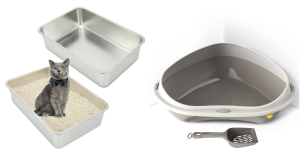
- Scratching is a normal cat behaviour and keeps their nails healthy. However, to save your sofa introduce a scratching post at a young age and encourage them to use it. For kittens, a small post is all that is needed, or they may prefer a horizontal ‘mat’ to scratch on. As the kitten grows, larger scratching posts will be needed.
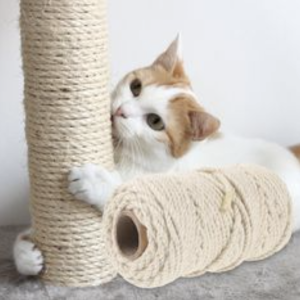
Kitten Hazards
A kitten’s curiosity can get them into trouble! Make sure their environment is safe from dangers by doing the following:
- Move potted plants to avoid nibbling, and never have toxic flowers such as lilies in the home;
- Close the washing machine and drier between uses and check before turning on;
- Cover hobs and oven tops after use to avoid kittens burning their feet;
- Seal up gaps and holes eg in skirting board, as kittens can squeeze through very small gaps;
- Keep bleaches and other cleaning products locked away;
- Avoid using disinfectants that are toxic to cats, eg phenolic disinfectants that go cloudy in water;
- Seal up other toxic liquids like antifreeze or washing liquids;
- Close windows to avoid kittens climbing out;
- Block access to fireplaces, wood burners or chimneys;
- Put away children’s toys, wool, cotton, hair bands, and string that is attractive to kittens to chew;
- Tidy up wires, chargers and cords to avoid the risk of electrocution.
Feeding Your Kitten
There are many food choices for kittens which can feel overwhelming. Importantly, cats are obligate carnivores, which means they must be fed meat and cannot be vegetarians without becoming seriously unwell. Feed a good quality kitten diet that is marked ‘complete’ as this means all the nutrients needed are included.
Initially, very young kittens coming home at 8-12 weeks will need to be fed at least four times a day as their stomachs are only suited to small, frequent meals. To start with, feed your kitten on the same food they are used to (if it’s a suitable kitten diet) and wait until the kitten is settled in before slowly transitioning to your preferred diet choice. If changing diet, initially mix a little new food into the old food and gradually reduce the amount of the old food. Check the packaging for amounts to feed and you may choose to feed a meal at a time or have food available all through the day. Exposing your kitten to both wet and dry food is sensible, so that they become familiar with different textures.
Some food can be provided in a ‘puzzle feeder’ when the kitten has settled in and is a little older as this can provide activity and keep their little mind busy.

Remember that some human foods are not suitable for kittens, so stick to kitten foods and treats. Avoid foods containing onions or garlic and remember that raisins and chocolate can be toxic to cats, and that cow’s milk, although tempting to give, can cause diarrhoea. ‘Cat’ milks are available, but are not needed and like other treats can fill up a kitten’s small stomach and deter them from eating food with all the nutrients they need.
Always provide fresh water in more than one location away from the food bowls and as the kitten gets a little older, water fountains with a moving water source can be introduced to encourage drinking.
Caring for Your Kitten
There is a lot more to caring for a kitten than just food and a comfortable bed.

Helping them become comfortable with people and other pets is termed ‘socialisation’ and this is a very important part of kitten ownership. Additionally, a kitten that is happy to be brushed, handled, and taken to veterinary clinics, will accept these things more easily as they grow into adult cats.
Socialisation
Much learning about life is done between two and around seven weeks of age, often before a kitten comes to your home. This is why ideally the kitten’s original caregiver (eg breeder or shelter staff) introduces experiences positively whilst the kitten is very young. However, once home, we can still help a kitten adjust. Remember the golden rules of not forcing a kitten to interact with people or environments they find frightening and allow them to choose whether to approach and when to retreat. Treats, stroking or playing can be used to encourage kittens to engage in new experiences positively. A few examples include playing sounds of vacuum cleaners quietly initially, providing treats and encouragement and when the kitten is comfortable, louder sounds or the real thing can be introduced. Once a kitten is more settled, they can be introduced to other types of people : old, young, male, female and noises, taking it slow and rewarding interactions with treats or playing.
Handling
Always handle kittens gently, they are fragile and can wriggle and be dropped causing injury. Never pick a kitten up by the ‘scruff’ on the back of the neck as this can cause fear and pain. Instead lift under the front legs with one hand, using the other hand under the kitten’s bottom for support.
Children and kittens can be great friends, but it is important they don’t squeeze or drop the kitten and it’s better if the child sits on the floor or the sofa with the kitten and offers a toy or treat rather than a cuddle, which can be very frightening – especially when the kitten first arrives. Gentle and brief stroking and allowing the kitten to choose when to end the interaction is always the best way to make friends. During the initial settling in period try to handle the kitten for short periods several times a day, giving breaks and always pausing the interaction to give the kitten chance to move away.
Try the ‘5 second rule’ of interacting with kittens and cats: touch or stroke the kitten for five seconds, then pause and assess if the kitten moves away or seeks further contact with you. If they engage in further contact (eg rubbing on your hand, playing with a toy) then continue, if they have had enough, let them move away.
Playing with your kitten
One thing kittens love to do is play! It keeps them fit and helps them learn about the world around them. Firstly, make sure toys are safe and don’t have small parts that can break off and be swallowed, and put away toys with strings or strips of fabric that could be a risk of strangulation. Kittens like to chase, pounce, and grasp and kick toys, so provide a selection for them to choose from. Low-cost popular options include rolled up paper, ping pong balls, cardboard boxes to jump in and out of and homemade puzzle feeders such as toilet roll tubes with a treat inside. Balls that roll and make noise can be fun, as can soft fabric mice and ‘wand’ toys with a feather or mouse on a stick or string. Rotating toys can make them seem new and exciting!
Never play with a kitten using your hands or feet. This seems harmless fun when they are tiny, but it creates bad habits and bites hurt as the kitten grows. If a kitten attacks hands or feet put the kitten down and move away. Try and be prepared to engage in play with a wand or a toy that can be kicked or thrown to distract the kitten before it goes to bite. Shouting or scolding can make a kitten even more excited or frighten them so it is better to divert and reward the behaviour we want.
Healthcare for kittens
Hopefully your new kitten will remain healthy, but it is important to register with a veterinary clinic for preventative healthcare and in cases of illness or accident. Ideally, you have a record of worming, flea treatment and vaccination when you bring your kitten home and your veterinary clinic can help you ensure that these are kept up to date. If possible, look for an International Cat Care accredited Cat Friendly Clinic (www.catfriendlyclinic.org) which has specific facilities and staff training to reduce a cat’s stress.
Vaccination
Vaccinations can protect your kitten from serious and life-threatening diseases such as feline panleukopenia (infectious enteritis/parvovirus), feline herpesvirus and feline calicivirus (cat flu viruses), feline leukaemia virus and in some countries, rabies. The initial vaccination course includes injections usually started at 8 weeks, a second injection 3-4 weeks later and a final injection at 16 weeks of age. This last injection is now recommended to ensure the kitten is fully protected. A ‘booster’ vaccination is then given from 6 months after the last vaccination. Future vaccinations will depend on the cat’s lifestyle (indoors or allowed outdoors, other cats, cattery visits).
Worming and flea treatment
Kittens are prone to worm infestations so worming treatment is important. Medicine should be obtained from the veterinary clinic to ensure it is safe and effective, and appropriate for the kitten’s age. Similarly with flea treatment, it is best to discuss with the veterinary team and never use a dog flea treatment on a cat as this can be fatal.
Neutering
Kittens can reproduce at surprisingly young ages (from four months of age) and so neutering is important and should be completed before kittens are allowed outdoor access. Neutering will also prevent unwanted behaviours such as spraying urine or wandering, as well as reducing the risk of various diseases. Castration (for male cats) and spaying (for female cats) can be performed from around four months of age.
Pet insurance
Insuring your kitten can alleviate the stress of veterinary costs in the event your kitten is unwell, as well as helping with other expenses such as the costs of advertising should the kitten go missing. Starting insurance as a kitten can mean health conditions that develop later are covered by the policy. Always read the policy carefully to ensure adequate cover for serious illness, lifelong cover (some policies may only pay for a condition for 12 months), and check for any other limitations and restrictions.
Keeping teeth clean
Dental disease is very common in cats, so training a kitten to tolerate teeth cleaning can prevent problems in the future. Start by gently touching around your kitten’s mouth and giving a reward, building up to putting a soft brush onto the teeth. Always use soft cat toothbrushes and pastes and seek advice from your veterinary clinic nursing team for further guidance and a demonstration.
Grooming and nail care
For long-haired cats, being comfortable with grooming is vital to avoid problems later in life, but for all cats, grooming can be enjoyable if introduced positively at a young age. Similarly, cat nails grow constantly hence the need to scratch, but for some cats (older cats, indoor cats) they may need to be clipped and during kittenhood is a good time to introduce handling of the feet. Start by gently touching the kitten with your fingers and rewarding with a small treat. Slowly you can touch areas such as the head, face and back. Once comfortable, extend this to touching legs and belly, again rewarding and keeping interactions short and positive. You can then start introducing a soft brush or even a soft toothbrush touching favoured areas such as around the face, allowing the kitten to rub on the brush. Brush a little and then reward with a tasty treat and build up the time and locations on the kitten’s body, always giving the option for the kitten to end the interaction when they choose.
Making introductions
How we introduce kittens to resident cats or other pets can make a lasting impact, so don’t rush it. Planning and promoting positive contact is worth the effort now to create lasting relationships between pets. Initially, keep the new kitten separate from other pets while they adjust to their new surroundings.
Introducing a resident cat
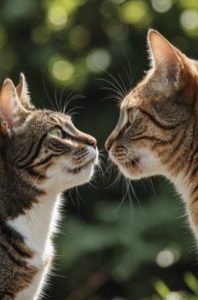
Cats do not necessarily get along with each other. The resident cat’s routine and environment should be kept as familiar as possible and the kitten kept in a separate room. Introductions start by mixing scents. Do this by using a soft cloth or cotton glove to rub around the kitten’s head and then rubbing this on furniture and corner of walls at cat eye-level. The resident cat can then get used to the new kitten’s smell. Bedding can be swapped between the kitten’s room and main areas over the first week or so allowing other parties to become familiar. You can also allow each cat/kitten access to the other areas when the kitten/cat is not present. Plug-in pheromone diffusers designed to facilitate introductions can be considered. Ideally visual introductions are made via a barrier. A glass or mesh door/gate for example, or a crate in the doorway of the kitten’s room can allow them to see each other without touching. Rewards of the kitten and cat’s preference can be used when they interact calmly (eg treats, playing with a toy, a soft groom). Once they seem calm in each other’s presence, they can be allowed to interact for short periods, with food or toys to distract. At the sign of any distress (eg hissing, the resident cat trying to get away) end the contact and try again later. Accepting a new kitten can take a resident cat time, and they should be allowed to avoid contact if they choose, and never forced to interact. All cats in a home should have ample opportunity to access beds, climbing frames, scratching posts, food, water and litter trays, so ensure that you have enough – placed in different areas.
Introduction to a resident dog
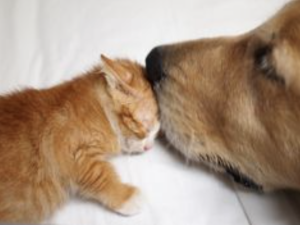
As with a resident cat, introductions to a dog should not be rushed. Kittens will vary in their experience of the canine species, and some may be fearful, others bold. As with cat to kitten introductions, smells should be mixed initially and dogs kept on a lead to avoid any chasing of the kitten. Ensure introductions are made when both the dog and kitten are calm (eg after some exercise) and use rewards to encourage calm behaviour in each other’s presence. Always supervise interactions initially and ensure that the kitten has places to hide/climb to away from the dog. Child safety gates can be used to prevent dogs accessing the kitten’s ‘safe’ areas and food.
Introduction to the outside world

You may decide to allow your kitten outside to explore, but this should be delayed until at least one week after the final vaccinations have been given, and once the kitten has been neutered. This often means kittens are around six months of age when they start to investigate their garden. There are a few things to consider to make this transition less stressful for both you and your cat:
- Cats can be trained to come back when called and this can be useful when they start to go outside. Before they go out, spend time teaching them to come to you when you say their name, or a trigger word. You can do this by calling them, and as soon as they turn to look at you, give them a small treat as a reward. Slowly increase the distance between you and your cat when you call, and reward when they approach you. Over time they will learn to come to you and this is helpful when they are allowed outdoor access. Always make coming back from outside a positive experience with treats or a meal.
- Start with short, supervised periods in the garden, bringing them indoors and rewarding, building up time spent outside.
- Microchip cat flaps can prevent unwanted cats in the house and you can teach the kitten to use it by initially propping it open and using a treat to encourage them to pass through, slowly lowering the flap so they need to push it open to get their treat.
- Think about creating an outdoor ‘latrine’ in a quiet area of the garden you can fill with sand, or turned over earth to encourage the cat to toilet there, rather than other areas of the garden.
- It is a good idea to keep your cat in at night (as traffic accidents etc are more common in the dark), so get into a routine of calling your cat in, rewarding, and distracting them with their food, a puzzle feeder or playing whilst you block or shut the cat flap.
Microchipping
Microchipping is a legal requirement in many countries and is a permanent way to identify your kitten if they were to become lost. The tiny ‘chip’ is placed under the skin and information kept centrally. Always make sure that your most up to date ‘contact details’ are registered.
What about a collar?
Collars can cause injury if a cat was to become tangled in vegetation, or they get their foot caught in the collar. If you are going to put a collar on your kitten, make sure it is of a ‘quick release’ type that breaks open in the event of an accident. Make sure the collar fits appropriately (and you can fit 2 fingers between the collar and the kitten’s neck).
Keeping indoors
If you decide to keep your kitten indoors then it is important to ensure they are kept fit and stimulated. This means providing opportunities to climb (climbing frames and shelving), to ‘hunt’ with toys that mimic prey such as wand toys, and puzzle feeding or hidden treats as a ‘treasure hunt’. Keep cardboard boxes to fill with scrunched up paper for example and scatter some treats amongst them so that the kitten can spend time finding them. A ‘catio’ or garden enclosure can allow safe fresh air and some cats will tolerate training to a harness but this takes time and patience.
Signs of illness in kittens
Like any young animal, kittens can become unwell quite rapidly, particularly when they are very young, so it is important to act promptly if they are ill, and seek veterinary attention. Weighing your kitten at home weekly is a good idea to ensure they are gaining weight as they grow. Failure to gain weight can be a sign of a problem. Weighing scales designed for babies are useful for cats, but as small kittens they can be weighed in a box placed onto kitchen scales. With both cats and kittens, changes in normal behaviour can indicate illness so look out for anything outside the kitten’s normal appetite, movement, litter tray use or energy levels.
Signs of illness in kittens include:
- Refusing food or eating less than normal.
- Seeming tired, quiet and reluctant to play.
- Vomiting (sickness) or diarrhoea.
- Discharge from the nose, eyes or ears.
- Difficulty passing urine or faeces.
- Bald patches or sores on the skin.
- Difficulty breathing, coughing or retching.
- Red urine.
- Smelly breath or smelly ears.
- Trembling, seeming wobbly (drunk) when walking.
This list is not exhaustive and any concerns should be discussed with your veterinary clinic promptly.
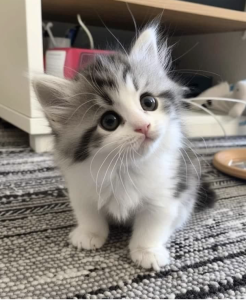
General
"The smallest feline is a masterpiece"
Leonardo da Vinci

 menu
menu